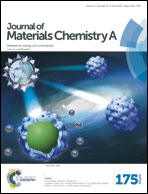Solid-oxide Fe–air rechargeable battery using Fe–Ce(Mn, Fe)O2 for low temperature operation†
Abstract
The effects of Ce0.6Mn0.3Fe0.1O2 (CMF) mixed with Fe for increasing redox properties were investigated in this study, and it was found that the reaction rate constant of Fe oxidation and reduction can be much increased through mixing with CMF. At 673 K, the oxidation rate constant of the Fe powder was higher than that of Fe without added CMF by an order of magnitude and the oxidation degree of the Fe is also increased from 10 to 80% at the initial time. When CMF mixed with Fe was set into the fuel chamber of a solid state Fe–air rechargeable battery, Ni–Fe/La0.9Sr0.1Ga0.8Mg0.2O3/Ba0.6La0.4CoO3, a discharge potential of ca. 1 V and a discharge capacity of 600 mA h gFe−1 was achieved at 673 K which is similar to the operating temperature of Na–S batteries. A stable discharge capacity was sustained over 20 cycles. In addition, the observed energy density of the present cell, 600 W h kgFe−1, was larger than that of the Na–S battery by 5 times and that of the redox flow battery by 30 times, and the efficiency of charging and discharging is almost the same. Since the Fe–air rechargeable battery is highly safe and environmentally compatible, it is promising for use as a stationary large capacity rechargeable battery, as an alternative to Na–S or redox flow batteries.


 Please wait while we load your content...
Please wait while we load your content...